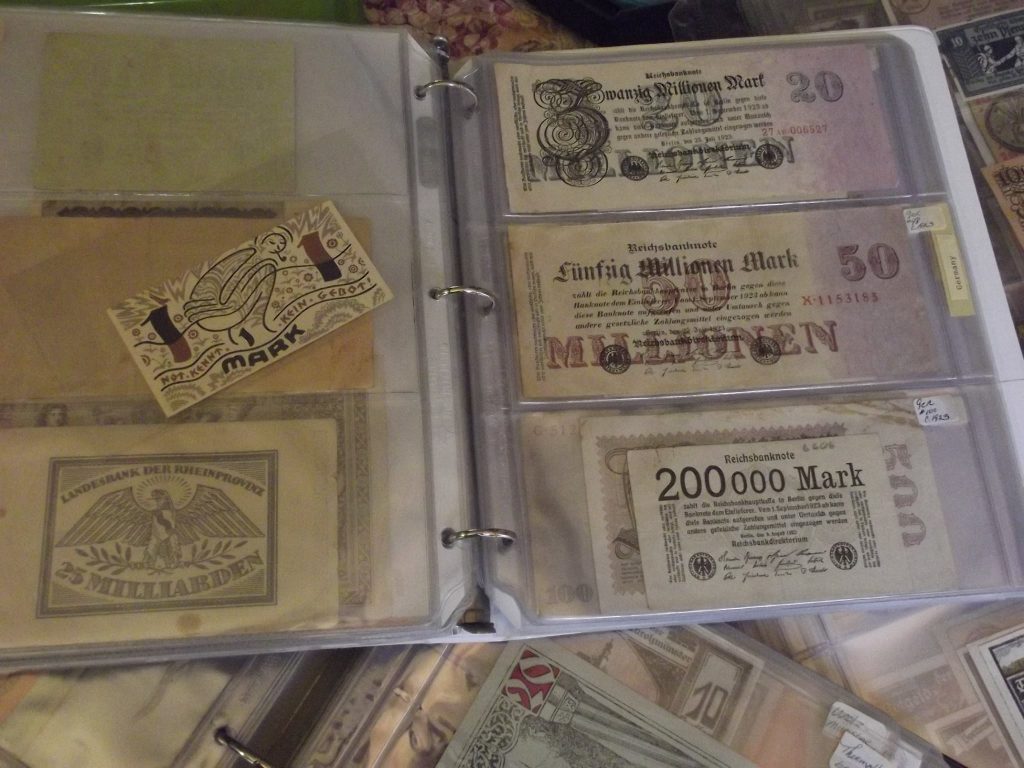A gift of money!
Or rather, paper currency!
 I am delighted to announce a fabulous gift of ephemera by our own staff member, Henry Arneth, who has been collecting these at paper fairs, shops, and eBay now for over 30 years. It comprises a total of 1,532 notes: 753 notes from 118 countries, and 779 “Notgeld” from 250 German and Austrian city-states.
I am delighted to announce a fabulous gift of ephemera by our own staff member, Henry Arneth, who has been collecting these at paper fairs, shops, and eBay now for over 30 years. It comprises a total of 1,532 notes: 753 notes from 118 countries, and 779 “Notgeld” from 250 German and Austrian city-states.
As Douglas Mudd has pointed out, “Among the most important and least studied [aspects of coinage and paper money] is the use of money as a means of communication through art. A nation’s money is often the first impression a visitor gets of the nature of a country. As such, designs and legends placed on money have always been considered important by the authorities responsible for their issue.”
The earliest paper money originated in China around the 7th century A.D. during the Tang dynasty (in the form of privately issued bills of credit), but paper money as we know it today was invented when the government of the Jin Dynasty began issuing Exchange Certificates in 1189. Marco Polo saw the exclusive use of paper money when he visited China from 1275-1292. In Europe it was Sweden which issued the first bank notes in 1660–not surprising, since it was easier to carry than their largest coins (copper “dalers”), which measured up to two feet long and weighed sixty pounds! (look it up).
The first American issue of paper money dates to 1690 in Massachusetts. Lacking specie (metal money) to pay its soldiers returning from Canada, the colony created bills of credit made out to the bearer and payable at certain banks.

 This 500-peso note from Argentina, for instance, features General José de San Martin (1778-1850), who arrived in Buenos Aires in 1811 (after fighting in the Spanish army against the French), and became one of the great “liberators” of Latin America.
This 500-peso note from Argentina, for instance, features General José de San Martin (1778-1850), who arrived in Buenos Aires in 1811 (after fighting in the Spanish army against the French), and became one of the great “liberators” of Latin America.
On the reverse side is the Cerro de la Gloria, or Mount of Glory. Overlooking the city of Mendoza, this colossal set of bronze statues with a Wagnerian look is the work of the sculptor Ferrari, who immortalized San Martin’s crossing of the Andes to liberate Chile and Peru (1818-1821).

 This 1-Zaïre note from the what WAS the country of Zaire, but since 1997 is the Democratice Republic Of the Congo, features Joseph Désiré, later Sesé Seko Mobutu, born in Lisala in 1930. He was Secretary of State, the Chief of Staff of the Congolese Armed Forces, and finally President of the Republic, and was a force for stabilization and growth. On the verso is a cornucopia and factory chimney. Mining was a major part of the economy–industrial diamonds and cobalt especially, as well as gold, tin, silver and cadmium.
This 1-Zaïre note from the what WAS the country of Zaire, but since 1997 is the Democratice Republic Of the Congo, features Joseph Désiré, later Sesé Seko Mobutu, born in Lisala in 1930. He was Secretary of State, the Chief of Staff of the Congolese Armed Forces, and finally President of the Republic, and was a force for stabilization and growth. On the verso is a cornucopia and factory chimney. Mining was a major part of the economy–industrial diamonds and cobalt especially, as well as gold, tin, silver and cadmium.
I should also mention other items that will be of interest to folks teaching or researching various subjects. Below is a 10-Krone note from a complete set (of 7) uncirculated notes issued on January 1, 1943 from the concentration camp at Theresienstadt (part of the former Czechoslovakia). All of them feature an engraved vignette of Moses holding the Ten Commandments on the recto. According to one scholar, Theresienstadt was established as a proposed model ghetto to impress foreign visitors and the Red Cross, but was actually no more than a transit point to the death camps in Poland. On the verso is a printed signature of Jakob Edelstein as “Der Alteste der Juden” (Eldest of the Jews).

 There are others of historical interest–issued by the military in wartime (Philippines, France, Russia) or by local polities which had no access to other types of credit.
There are others of historical interest–issued by the military in wartime (Philippines, France, Russia) or by local polities which had no access to other types of credit.
Lots for the student to explore!
Sources for this post:
Douglas Mudd, All The Money in the World: The Art and History of Paper Money and Coins from Antiquity to the 21st Century (New York: HarperCollins, 2006).
Martin Monestier, The Art of Paper Currency (London, Melbourne & New York: Quartet Books, 1983).